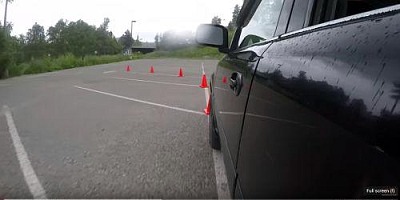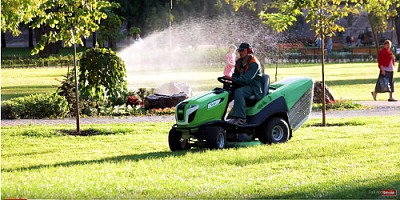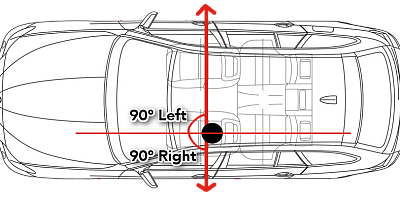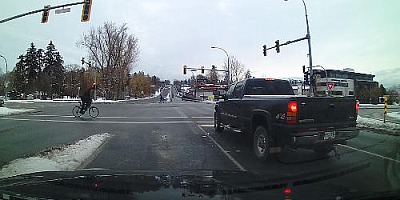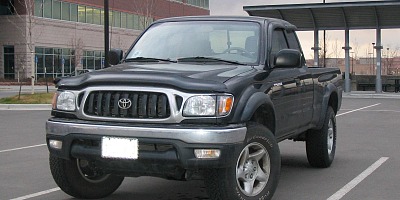Step-by-step instructions to work the secondary controls to pass your driving test first time - watch the video!
How to Work the Secondary Controls to Pass Your Driving Test
Closed Caption
Introduction
 Hi there smart drivers.
Hi there smart drivers.
Rick with Smart Drive Test talking to you today about the instrument panel on the vehicle.
This is for new drivers working towards getting their license and starting driving.
Now just before we get started here: if you're working towards the license or starting a career as a truck or bus driver, lots of great information here on the channel.
Make sure you hit that subscribe button to get first notice to all of the new videos as they come out.
Now instrument panel on the vehicle.
This is a new 2017 Nissan Murano.
I rented this car because I'm on a trip to Toronto--actually I came down for a YouTube conference.
So I thought this is a great opportunity to go over the instrument panel because it's a newer vehicle and this is what you're going to encounter if you have a new vehicle or your parents have a new vehicle or whoever's vehicle that you're using.
So this will be a better representation of what most of you are going to be driving.
Now if I miss anything or I don't go over enough detail, leave a comment down in the comment section there and I'll do another video to provide detail or explanation of one of the features on the vehicle and give you more explanation of that feature.
Get Your "How to Pass Your Driver's Test First Time"
• FEAR :: Learn the correct skills, abilities, and techniques that are required to pass your driver's test;
• SELF-CONFIDENCE :: Get the exact skills from a licensed driving instructor that will guarantee your success;
• CONFUSION :: Cut through the conflicting and incorrect information;
• QUALIFIED :: Smart Drive Test has helped 1000s to pass their drivers' test...and we can help you!
So by all means, leave me a comment and I'll be more than happy to go over that for you and give you more detail about certain features on the vehicle.
But today, basically what we're going to do is we're going to go over the controls that you need to know for the purposes of driving the vehicle.
In other words, how to adjust the seat, how to turn the lights on, how to turn the windshield wipers on, how to operate the controls.
What's on the steering wheel, the windows, the door locks, not so much with the radio controls and the telematics and the navigation system that's here in the center of the screen.
That doesn't really--isn't really needed for the purposes of learning how to drive and preparing for a road test.
So we're not going to go over a great deal of that.
We will go over the heater controls because if you're learning how to drive when it's fall or spring or it's in the wintertime, you're going to need to work those controls because the heater controls and the defrost controls to keep the windows clear.
Because one of the major components of a road test is observation.
You're going to need to be able to see.
As well.
we'll go over the gear selector and show you how to work that.
The heated seats, how to start the vehicle and those types of things.
And some of the airbag features and safety features of the vehicle.
And the glovebox and whatnot, but for the most part it's the controls that you need to know and need to know how to operate for the purposes of learning how to drive and preparing for your road test.
So stick around, we'll be right back with that information.
Prologue
Hi there smart drivers, welcome back.
Rick with Smart Drive Test talking to you today about the control panel and the features that you need to know for the purposes of learning how to drive and to prepare for a road test in a vehicle.
As I said at the beginning here, I am in Ontario, Canada at my Mom's visiting.
I rented a car.
It's a 2017 Nissan Murano--actually it was a happy day for me because the rental company upgraded me from a midsize to a full-sized vehicle.
So this is a full-size SUV and it's a brand new vehicle.
It's got all of the telematics and new controls and features - and intelligent key fob.
Key
You know it's a keyless entry, as most of the new vehicles are.
They don't have keys.
One of the cons that I would say is, they really need some place - a specific place to set the key, because in the old cars that actually had keys and you turn the key in the ignition, the key goes somewhere.
Whereas in the newer cars the keys don't go somewhere and unfortunately the key fob is something easy to lose.
Door Controls
So the first thing - we're going to start with - we'll start with the driver's door.
And the controls that are on the door, these are fairly straightforward Most new vehicles are going to have electric windows.
And there'll be a switch for right and left mirror.
So you just move the switch to the right or to the left, whichever mirror you want to adjust.
And then it's a four-way control that will adjust the mirror up-down left-right.
And again, I'll leave a video up here for you for the 8 steps that you need to adjust a new vehicle when you get into a new vehicle.
How to set it up for you so you're comfortable to drive.
And I'll leave a card up here in the corner, so make sure you check that out for learning how to drive.
Just turn the key to the off position here because it's beeping at me, as they do on a regular occasion.
So you've got the power mirror control, you've got the door lock on the door here, which most the time its power and it's going to work off the key fob.
And it's just a lock and unlock symbol on the key fob will lock and unlock the doors.
So most of the time, you're not going to work this [POINTING TO THE LOCK NEAR THE DOOR HANDLE].
As well, on these newer vehicles as soon as you get over 10 kilometers now or 20 kilometers (10-15mph) an hour the doors will lock automatically.
And there's a couple reasons for that:
1) one is to keep thieves out;
2) and the other reason is that if you can keep the doors closed in the event of a rollover it maintains the integrity of the vehicle.
In other words, the vehicle is stronger with the doors closed then when they're open if the vehicle is rolling over.
And it's going to better protect you in the event of a crash.
You can lock out the window control.
So the windows don't go up and down.
This is for the rear, if you've got kids in the back, they can't have the windows going up and down.
So you can lock that with that control.
All four windows: so on the driver side you'll be able to roll up and roll down all four windows.
The one other feature on this and most newer vehicles will have this, is it has seat adjustment presets.
So what you can do is adjust the seat to your liking.
And there's three controls on the side of the seat.
Seat Controls
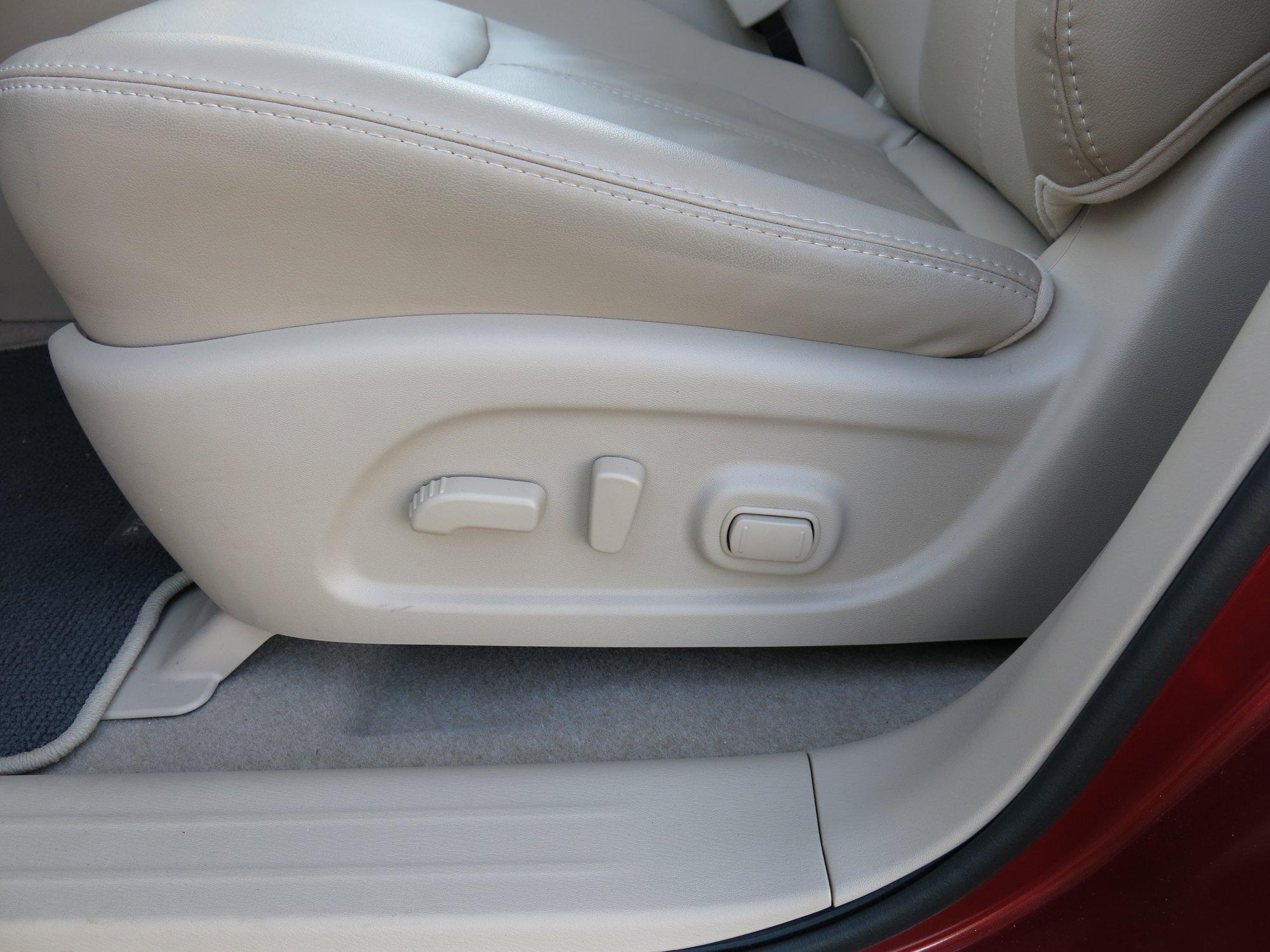 This is an electric seat.
This is an electric seat.
So there's back, forward, tilt up and down.
So the seat will tilt up and up and down like this, and then the back will go back and forward.
And then there's a lumbar support on this seat as well, which is a piece on the back of the seat that comes out and supports the lower back if you've got lower back pain.
So you can set all that up and then you can have presets for two separate drivers.
So after you get it all set up, you push the button and it'll automatically preset for that person.
If you need more information about that, you can find that in the owners manual.
And there you can find more information about that.
That's what I was trying to say...
I got distracted there because when I hit the button for the seat and it started moving on me.
Lights
The next one is the windshield wiper....no, not the...
sorry, the headlights.
So you've got OFF, AUTO--the lights will come on automatically, because there's a photo sensor in the headlights.
And so you turn it to AUTO and you can just leave it and the lights will go on and off by themselves.
You have the PARK lights.
So if you're sitting somewhere and your parked, the two orange lights on the front and the tail lights will be on - the parking lights on the back.
So that's your parking lights.
And then full lights, and that's how you work that.
There's another switch on here for the fog lights on the front.
And that's separate - that's located inside on the switch.
And then once you have the headlights on, you have high beams.
You push it away from you and then pull it back for low beams - high beams, low beams.
And at night you need high beams, low beams.
Now the other thing you can do is you can flash the high beams.
You just pull it towards you and you can flash the high beams.
And that's good for talking to other vehicles if you want to move them back and those types of things - trucks and whatnot.
So that's another video.
So that's the headlights.
Windshield Wipers
On the other side of the steering wheel--and it will vary.
These will be on different sides of the steering wheel depending on whether you're in Europe with you in North America.
The other thing on the headlights, which is the turn signals.
Down is left, and up is right.
So that way for the right, down is to the left on this vehicle.
And then on the other side you have another switch.
You have this for the rear and forward front windshield wipers.
The outside of this switch switch specifically is INTERMITTENT.
So it activates the wipers once in a while it goes on.
And then ON is full on for the rear windshield wiper on the back.
And then you pull it towards you to spray windshield washer fluid on the back.
You push it away from you to spray windshield washer on the front.
And then the front has the same, OFF, INTERMITTENT, LOW and a HIGH setting.
And you simply--just instead of turning this for the windscreen wipers on the front, you push it down for INTERMITTENT, twice down is on LOW, and then all the way down is HIGH.
And of course it'd better be raining pretty hard if you're going to need the wipers on a high [CHUCKLING].
Most of the time you're not going to need it on a HIGH.
Instrument Panel
All newer vehicles are going to have a tachometer.
The tachometer indicates revolutions per minute of the motor - how fast you're actually revving the motor.
So it's in one, two, three, four.
And all of those numbers are times a thousand.
So it's 1,000, 2,000, 3,000, 4,000.
Now all tachometers are going to have a red line on them.
You do not want to redline the motor okay.
You simply want to have it up 5,000, 6,000 rpm.
If you are redlining it--which is the top sort of 2,000 rpm--you don't want to be doing that.
So the other one is the speedometer.
Most vehicles are going to be in miles per hour and kilometers an hour.
Now obviously in Canada, we're in kilometers per hour.
I believe in Europe they're in kilometers per hour, and in Australia.
In North America, they're going to be miles per hour.
Now as well, you have a temperature gauge for the motor.
And you have the fuel gauge.
And also, most of the newer vehicles are all going to have warning lights on them - that if you run it down below a quarter of a tank, there's going to be a light that comes on that tells you that it is down and the fuel is low.
And you should really put some fuel on it.
| Don't Fail Your Road Test!! | |

A course for new drivers working towards their first license. |
This self-paced course gives you:
|
Controls on the Dash (Left)
Now down here on the left side, there's some more controls down here as you can see in the image here.
One of them is for the dash lights and how bright the dash lights are.
And if you're driving at night--and I'll put the video up here in the corner for you on night driving--try and have these down as low as you can.
Because that will reduce fatigue when you're driving at night, because it it draws on your eyes.
when you've got bright light there on the dash.
So you want to try and turn those lights down at night and really help to reduce fatigue and reduce distraction at night.
So that's here on this vehicle.
Sometimes it's on the dash itself - there's a switch.
Also there's the trip set here, which is the tripmeter which you can tell--you can set that to zero--and it'll tell you how far you're going to go for a trip.
And most new vehicles will have one or two tripmeters.
And one of them, you can track your fuel mileage, the other one you can set for how far you're going to go if you're doing business trips and those types of things.
So that's the tripmeter.
And then the other thing this...[CHUCKLING] this vehicle actually-- talk about decadence--this one has a heated steering wheel and heated seats.
So I was reading in the owner's manual that the heated steering wheel will only work if the temperature of the steering wheel is less than 20°C or 68°F, so if it's less than that than the heated steering wheel will work, but otherwise it won't work.
So just know that.
Traction Control
The other one is what's called the traction control.
It has a different name on the Nissan.
I can't remember it, but it is in the owner's manual - you can look it up.
But it's essentially traction control.
If you get into wheel spin in slippery conditions--ice and snow, those types of things--the traction control will reduce power to the wheels and allow it to get traction to move.
Now you can turn that off and on, if you're in slippery conditions and do need to give it some throttle and really spin the wheels to get it going and get it out of that deep snow or mud or whatnot.
Hatchback & Fuel
And then the other switch down here is the tailgate, which simply opens the hatch back on the back.
Not tailgate, it's the hatchback rather.
And that's a power hatchback on this vehicle that will open and close the tailgate automatically.
Now farther down from that is the fuel cap lock switch that will unlock the fuel cap.
And as well as the hood latch.
So both of those are down farther.
And again this one on the fuel gauge has an arrow and most of the newer vehicles will have an arrow on the fuel gauge that will tell you which side the fuel cap - the fuel filler is on the vehicle.
So this one is on this side it's - on the driver's side.
So when you look at the fuel gauge [CLEARING THROAT] excuse me, look for the arrow and that will tell you where which side the filler cap is on on the vehicle.

Parking Brake
Now right down on this one, the parking brake is not a hand parking brake on this one.
It is a foot pedal, so you push it down.
The pedal locks, and then to get it unlocked you have to push it in a little bit-- farther down, and it will release and then let go.
And the pedal will come back up.
So that's how you release that.
Now I'm not going to talk too much about the controls that are on the steering wheel because essentially we have the cruise control on the steering wheel.
Steering Wheel Controls
And there's another video, I'll put a card up in the corner for you on cruise control.
You can look at that video and it will explain the buttons that you use and how to work cruise control more thoroughly.
There's some audio controls for the phone and those types of things.
And again I advocate that if you do have a phone, hook it into the speaker system and that way you're using hands-free system.
There's a switch on the steering wheel to move the information that the dash displays for the air pressure in the tires, the distance for that you have for fuel mileage, which direction you're traveling, the speedometer - there's a lot of information there and all of that can prove distracting.
And then there's the volume control for the stereo on the steering wheel.
Centre Top Switches
So that's all of that information.
And then the newer vehicles all have these built-in on/off switches for your garage door opener for those of you that have automatic garage door openers.
You can program this.
So that those are there.
Up here you have some switches for interior lights.
Most of these newer vehicles will have a sunglasses compartment here that you can put your sunglasses in.
I guess you could put your keys into there if you were looking for a place to keep your keys.
All of these will have sun visors - most of the new sun visors have a mirror--a vanity mirror--and they will have a light on the vanity mirror.
Rear view mirror [POINTING] Again...yes...
Okay, so therear view mirror and there's another switch on here.
I'll have to look this up for you and see what this is.
Sun roof up here.
We went over the seat controls.
The gear selector - I'm going to do another video on the gear selector and I'll show you how to work the gear selector.
The switches for the heated seats are here.
Passenger Side Airbag
As well, if there's nobody sitting in the passenger seat on this vehicle it will detect that and the light will come on here telling you that the passenger airbag has been deactivated.
Because there's nobody in the seat.
If there's somebody in the seats, the airbag on the passenger side doesn't have to deploy.
So that's why that will come on.
As soon as somebody sits in the seat and there is a certain amount of weight, the airbag will deploy.
The other reason that they have that is because there has to be a certain amount of a pressure on the seat.
In other words, if there's a child sitting on the seat the airbag will not deploy on the passenger side.
So the person has to be of a certain size and a certain weight before the airbag on the passenger side will deploy.
And that is the reason for that.
Now the other piece on this is...
I'll just turn the key to the on position here.
Climate Controls
So on/off, and you have the controls for the heat and defrost, and essentially what you have is you have the forward and a rear defrost on here.
You can increase the fan on/off and you can push Auto as well.
And you can have recycle or fresh air coming through the cabin.
If you're working in the wintertime or you just need it to heat up more quickly, one of the things you can do is push the recycle button and that will recycle the air in the cabin.
And it will heat up faster.
So that's one of the ways that you can do that.
The other way that you can get the cabin to defrost quick more quickly or get moisture off the windshield is to turn the air conditioning on while you have the defrost on.
That will draw the moisture out of the air with the air conditioning system.
So that's the other way you can do that.
And if you want to see the video on cold starts here, that will explain the procedure in more detail.
I'll put a card up here for you in the corner.
Now when you start the vehicle up.
As I said, it has a key fob.
Ignition Switch
If you want to start the vehicle up...
I'll just turn this off for a second.
If you push the start button once and you don't have your foot on the brake pedal it will go to ACCESSORY.
So if I push that it will go to ACCESSORY and you can sit and play the radio and those types of things.
Now if I push it again, it will go to the ON position.
Wen it goes to the ON position, all the signal lights and warning lights activate, and it does the systems check in the system.
And everything comes on, so that you can hear the defroster and those types of things are on now.
I'll just turn that off.
And the third time I push it, it'll go off.
Now, if I want to start the vehicle with the keyless ignition, I have to put my foot on the brake pedal.
As soon as I put my foot on the brake pedal, and I push the button, now it'll start the engine.
So now it started the engine.
The tachometer and the speedometer cycle through and then it goes back on.
Now when the ignition is off, the fuel gauge will go to zero until you start the motor the fuel gauge won't come up.
[ENGINE STARTED] So now it comes up to a half tank as you can see here in the image.
Now all the gauges are working.
The tachometer is showing you that the engine is turning over a little bit more than 1000 rpms per minute - it's in revolutions per minute in terms of how fast the engine is turning.
The temperature gauge and those types of things - all of the warning lights have gone out.
So the only thing that's on now is the parking brake sign and the seatbelt sign and there's another warning light on here and I'll have to look that warning light up for you to tell you what that is.
So that's essentially what the information that you need to know for the controls on the vehicle for getting starting to drive and preparing to pass a license test.
And those are the main controls that you need to know.
Now telematics and those types of things - all of that stuff you can look up in the owner's manual.
But if you want, I can do another video on telematics.
Just put a comment down in the comment section there, and I'll be sure to get that done for you.
Conclusion
Quick review of the instrument panel in preparation to learn how to drive and to pass a road test.
The primary controls and the secondary controls - these are the secondary controls that you need to know in order to be able to drive the vehicle.
Now most of the controls you're not going to be using while you're driving.
Some of them you will be: signal lights, windshield wipers, windshield washer fluid, tachometer, speedometer - you're going to be monitoring those gauges and looking at those gauges.
You need to have some idea of what the warning lights are on the dash.
The warning light that I saw when I turned the vehicle on was telling me the passenger door is open because the cameras sitting over there and the door is open.
So that's what it was telling me.
I looked it up in the owner's manual while we were transitioning to the conclusion.
So that's what the warning light was telling me.
These new vehicles tell you everything.
So it told me that the passenger door was open DUH [CHUCKLING].
So power mirrors, windows here on this side, the power door locks, the presets for the seat, if you have an electric seat in your vehicle.
The controls will be down on the left side of the seat - backwards, forward, tilt, the back, headrest.
Again, look at the eight lessons on the card up in the corner there.
That will show you how to set up the vehicle.
Headlights on this side - auto, parking lights which are the orange lights and tail lights, and then full-on high beams, low beams which is to push it forward on this vehicle for your high beams.
You can flash the high beams.
And then left signal, right signal.
This side is the windshield wipers for the front and windshield wipers for the back.
Both of them have intermittent.
As well, you can adjust the intermittent - how fast they're working if it's not raining too hard.
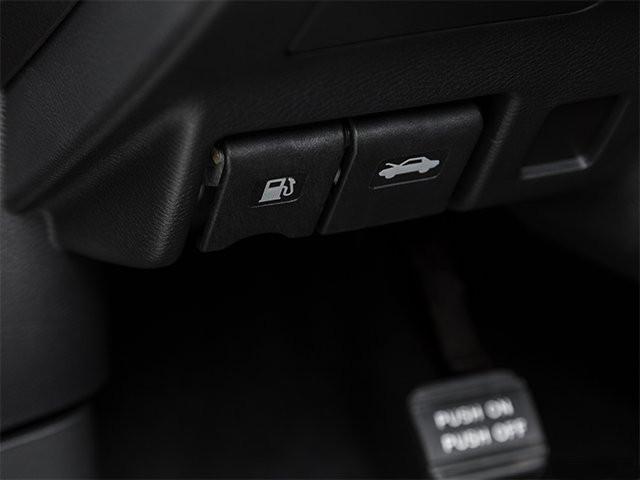 The controls for the cruise control.
The controls for the cruise control.
Again look at the card up in the corner here for cruise control.
You have your controls for your audio - how loud your audio is and again make sure you hook your phone into your stereo system on your vehicle.
You have the information on the dash - lots of information with the compass, how much pressure is in your tires.
All new vehicles have to have a tire monitoring system that will tell you how much air pressure is in your tires.
So you can just flip through that and figure that out.
There will be a tachometer on the left, the speedometer will be on the right.
The tachometer is in revolutions per minute.
A temperature gauge will tell you how hot the engine is running and you get used to the vehicle.
If it does go into the red, make sure you get the vehicle pulled over as soon as possible and get it to a technician.
As well, the fuel gauge - most new vehicles will have a warning to tell you if you've got low fuel in the vehicle.
And as you saw in the image here, you can see that as soon as they start the vehicle up, the parking brake and the seatbelt sign will come on to tell me that I need to disengage the parking brake before I leave and I need to put my seat belt on for purposes of safety.
Heater controls - you need to know how to work that.
Set up your mirrors, and again that's in the 8 steps of setting up a vehicle video for you.
So both for comfort and for being able to control the vehicle, make sure you wearing your seat belt while you're driving because in the event of a crash or a likely crash the seat belt will keep you in the seat.
Tough to control the vehicle if you're not in the seat; so wear your seatbelt for that purpose.
And in the event of an impact it will also protect you in the event of an crash and reduce injuries.
You'll have to know how to work the heater controls, particularly if you're in the spring, the fall, you get a cold day and those types of things because you're going to have to defrost the windows because one of the main parts of a road test is observation and being able to see.
Up here you have interior lights, your sunglasses, and those types of things.
Power windows and all of that.
You have the hatchback, traction control, seat presets, and your lights on your dash.
And again, when you're driving at night, lower the lights on the dash.
That way it's going to reduce fatigue and reduce the strain on your eyes and you'll be able to last longer at night.
And there isn't as much distracted driving.
Again, have a look at the video on night driving up here in the corner.
So that's the basic control panel of the vehicle.
As I said, most of them are all going to be keyless entry, so you've got to keep track of the fob.
It has to be within a certain distance of the vehicle for you to be able to start.
And the starter button on these - if you push it once, it'll go to the ACCESSORY.
So if you're sitting around waiting for somebody at the store or whatnot you can turn it on to ACCESSORY and you can play the radio and those types of things.
The next one will turn it to the ON position, where it'll cycle through and all the electricity will be going to the battery and those types of things.
And then if you actually touch the brake pedal and push the button, it'll start the motor.
Those are the basic features that you need to be able to drive the car and to operate the controls while you're driving the vehicle.
Now if you're not familiar with the newer vehicles, get used to where the controls are and those types of things before you take off.
And again, make sure you look at the eight steps to setting up the vehicle for learning how to drive and passing a road test.
Question from my smart drivers:
Was there anything in the video here that I didn't go over that you want more detail?
Leave a comment down in the comment section there - all of that helps out the new drivers working towards their license.
If you like what you see here share, subscribe, and leave a comment down in the comment section.
As well, hit the thumbs up button.
Check out all the videos here on the channel if you're working towards a license or starting a career as a truck or bus driver.
Lots of great information here.
As well, head over to the Smart Drive Test website - awesome information over there and online courses that you can purchase.
Later this month, we're bringing out "air brakes explained simply" It's for drivers operating commercial vehicles that are equipped with air brakes - truck, bus, or RV unit.
Step-by-step instructions that update the 40 year old air brake manuals that are currently in circulation in North America.
As well, there's no less than 100 CDL questions - practice multiple-choice questions that you be asked on a CDL exam.
So look for that later this month.
I'm Rick with Smart Drive Test.
Thanks very much for watching.
Good luck on your road test.
And remember, pick the best answer, not necessarily the right answer.
Have a great day.
Bye now.
[CLIP - RV TRAILER PULLING OVER TO SIDE OF ROAD TO LET OTHER TRAFFIC PASS]


